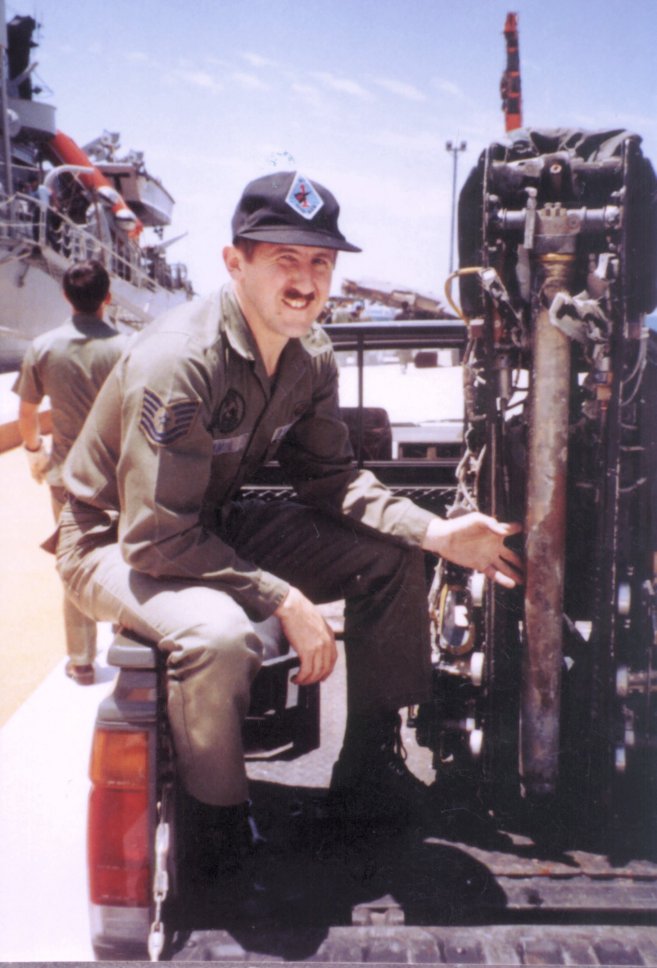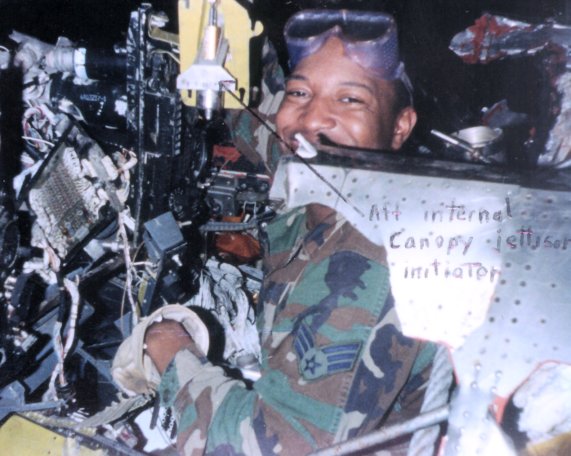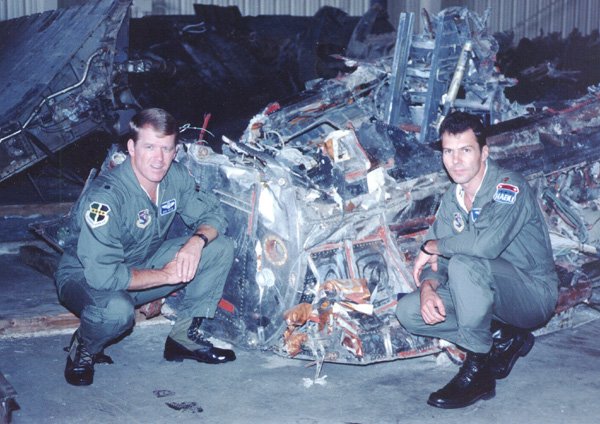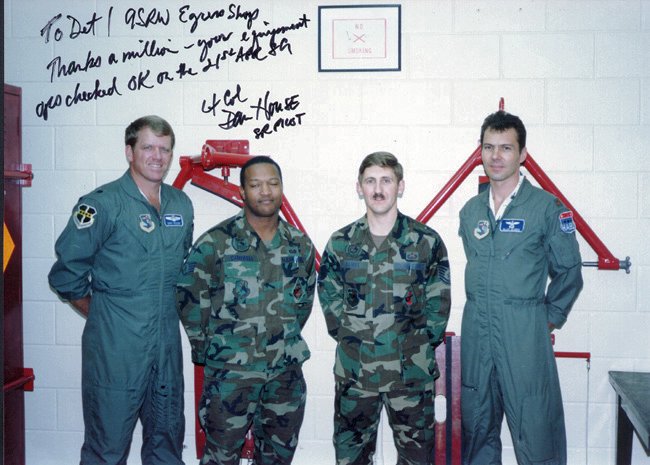

These photos document the recovery and disarmament of the cockpit section of SR-71 17974, lost 21-Apr-89 near the island of Luzon in the Philippines. They also show some of the risks that an egress shop might have to deal with in connection with a mishap. In this case, both crew members, LtCol Dan House, pilot, and Maj. Blair Bozek, RSO, were saved by the use of the SR-1(4AQ-1012) ejection seats. The ejections occurred at low altitude and low airspeed after an engine failure ruptured hydraulic lines while the aircraft was at speed and altitude. After a complete loss of control that lasted as the aircraft decelerated from Mach 3+ to below Mach 2.5 the pilot managed to bring the aircraft under some control as they descended and decelerated further. At some point control was lost again leading to the aircraft entering a falling leaf spin where it 'falls off' to one side, sliding downward, and then arcing back up sort of like the half-pipe shape used in skateboard and snowboard competitions. During these oscillations LtCol House called for ejection and proceeded to eject himself at about 10,000ft. Maj Bozek in the aft seat stowed some gear including his checklist (which was rather thick and weighed a few pounds) before ejecting. As the aircraft was still in the falling leaf he actually ejected at a higher altitude than the pilot.
LtCol House observed the aircraft then go over the top of a loop and stall out, entering a flat descent in planform. The aircraft struck the South China Sea and was gone from sight instantly. Both crew were rescued by local fishermen in outrigger boats called Bonka boats.
The aircraft was located on the ocean floor at a depth of about 120 ft and recovery operations were successful to raise the majority of the wreckage including all sensors, the main body, both engines, and the forebody section including the cockpits. One of the two ejection seats was also located and recovered. The second seats location is shrouded in myth. One story has it used as a throne by a local tribal chief. Another has it recovered by a later group from a barber shop. The truth may never be known.
Two members of Detachment 1 of the 9th Strategic Reconnaissance Wing, Sgts Hamel and Campbell, who maintained the SR-71 egress systems at Kadena Air Base, Okinawa, Japan, were assigned the task of disarming the cockpits and seat of any residual live charges before the investigation could continue, and the wreckage disposed of. This is a job often handled by the Explosive Ordinance Disposal units, however the specialized knowledge of the egress professionals often has them involved.
Egress systems often have dual initiation methods and backup initiators that are not fired during a 'normal' emergency. The Egress troops knowledge of the system allows them to remove all the parts safely. They also examine the equipment to be able to assist the mishap review board by notifying them of any failures or unusual indications. In this case, the seat recovered showed that it had performed as expected.
The damage to the seat from water impact blew out the central section of the seat back and curled the sides of the parachute back support area. The drogue gun was seen to be missing the slug, with the cartridge fired indicating it functioned correctly. The seat firing handle was missing , and the cutters for the leg restraint lines and firing handle were in the fired position with the cables severed. The seat separation strap assembly was retracted into the rotary actuator. One of the two lower attachment points was torn loose, however that could have happened either in water impact or during recovery. The inertia reel straps were severed. Lap belt releases were in the open position and lap belt was not present. Quick disconnects had released correctly.

Tech Sgt Hamel examined the seat when it was off-loaded from the recovery vessel. Later on he and Sgt Campbell disarmed the cockpit sections and examined the egress systems there. Among the other parts recovered were the internal canopy jettison initiators, neither of which were fired. This indicates that both crewmen initiated ejection without separately jettisoning the canopies. Fired parts identified in the shattered wreckage included both catapult tubes (these are the outer section of the rocket catapults), the canopy seal hose cutters, the canopy unlock thrusters, and the canopy jettison thrusters. All these parts need to work for a successful ejection, and all did, in both cockpits.

To examine and recover these parts Hamel and Campbell had to enter both cockpits, filled now with jagged, torn metal that once had been the structure of the aircraft. The most untouched part of the cockpits were clearly the seat track assemblies. Both sets stood tall with the empty catapult tubes between them. The only damage to them was in some of the cross supports where the rocket exhaust from the rocket portion of the ROCATs impinged Suit vent hoses that automatically disconnect from the seat on ejection lay in the back of the cockpits with the lanyards that released them. Nearby the aircraft portions of the quick disconnects dangled loose. Behind the seat track assemblies the canopy seal hose cutters, the canopy unlock thrusters, and canopy jettison thrusters were visible.

Inside the sidewalls of the cockpit tub, the canopy jettison initiators had to be unbolted and removed. Since these initiators were still live, and had been exposed to sea water, care had to be used. These initiators had to be removed and stored in explosive safe areas.

After the cockpits were declared safe, and the aircraft wreckage was stored in a hanger for examination by the mishap review board personnel, the aircrew paid a visit. LtCol House and Major Bozek are pictured here in front of the cockpit section. They both thanked the egress shop personnel, and LtCol House later signed the below photo for them.

The photos are from the Hamel Collection, used with permission.
CMSgt Hamil asked that I provide this link to the Air Force Enlisted Heritage Research Institute web site.
| The Ejection Site Home | |
|---|---|
| Send email to Kevin |